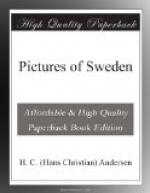The road still leads us a long way on this side of the mountain, step by step downwards, in long terraces of rich fields: further down, the slate-stone peers forth in flat layers, a green moss upon it, and it looks like threadbare patches in the green velvet carpet. The high road leads over an extent of ground where the slate-stone lies like a firm floor. In the Campagna of Rome, one would say it is a piece of via appia, or antique road; but it is Kinnakulla’s naked skin and bones that we pass over. The peasant’s house is composed of large slate-stones, and the roof is covered with them; one sees nothing of wood except that of the door, and above it, of the large painted shield, which states to what regiment the soldier belongs who got this house and plot of ground in lieu of pay.
We cast another glance over Venern, to Lockoe’s old palace, to the town of Lendkjobing, and are again near verdant fields and noble trees, that cast their shadows over Blomberg, where, in the garden, the poet Geier’s spirit seeks the flower of Kinnakulla in his grand-daughter, little Anna.
The plain expands here behind Kinnakulla; it extends for miles around, towards the horizon. A shower stands in the heavens; the wind has increased: see how the rain falls to the ground like a darkening veil. The branches of the trees lash one another like penitential dryades. Old Husaby church lies near us, yonder; though the shower lashes the high walls, which alone stand, of the old Catholic Bishop’s palace. Crows and ravens fly through the long glass-less windows, which time has made larger; the rain pours down the crevices in the old grey walls, as if they were now to be loosened stone from stone: but the church stands—old Husaby church—so grey and venerable, with its thick walls, its small windows, and its three spires stuck against each other, and standing, like nuts, in a cluster.
The old trees in the churchyard cast their shade over ancient graves. Where is the district’s “Old Mortality,” who weeds the grass, and explains the ancient memorials? Large granite stones are laid here in the form of coffins, ornamented with rude carvings from the times of Catholicism. The old church-door creaks in the hinges. We stand within its walls, where the vaulted roof was filled for centuries with the fragrance of incense, with monks, and with the song of the choristers. Now it is still and mute here: the old men in their monastic dresses have passed into their graves; the blooming boys that swung the censer are in their graves; the congregation—many generations—all in their graves; but the church still stands the same. The moth-eaten, dusty cowls, and the bishops’ mantle, from the days of the cloister, hang in the old oak presses; and old manuscripts, half eaten up by the rats, lie strewed about on the shelves in the sacristy.




